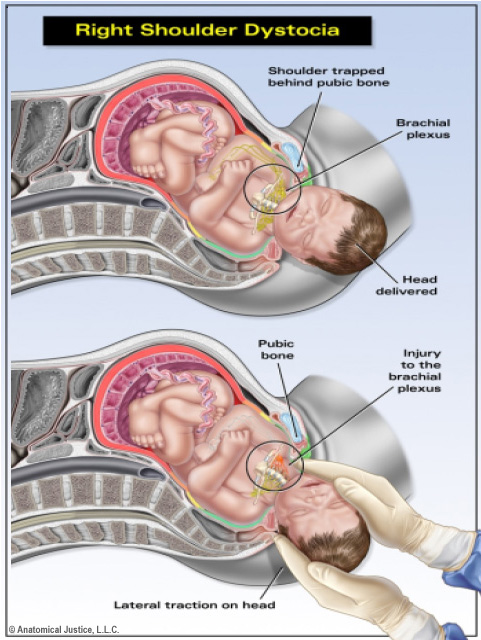New Jersey Shoulder Dystocia Lawyers
What Is Shoulder Dystocia?
In the process of giving birth, once the baby’s head is delivered, one of the newborn’s shoulders may become impacted behind the mother’s pubic bone, causing the body of the baby to become “stuck”, and making the delivery more difficult. This is termed “Shoulder Dystocia”. Risk factors for shoulder dystocia include gestational diabetes and/or “fetal macrosomia” where the baby’s weight is estimated at and about the time of birth to be in excess of 4500 grams (9 lbs. 14.5 oz.), or, relative macrosomia in excess of 4000 grams (8 lbs. 13 oz.) in a woman of smaller stature with a narrower pelvic outlet.

HOW SHOULDER DYSTOCIA SITUATIONS BE HANDLED IN NJ?
There are a number of “maneuvers” accepted within the obstetric community which a healthcare provider may employ in order to free the “stuck” shoulder and baby. However, obstetricians and other healthcare providers occasionally utilize these maneuvers incorrectly, or, not at all. Instead, those attending to the delivery sometimes apply excessive downward force on the baby’s head and neck in an effort to alleviate the dystocia. A failure to properly use the appropriate maneuvers and/or the application of excessive force may be considered medical malpractice, and, could result in injuries to the brachial plexus nerves controlling the shoulder, arm, wrist and hand/fingers. In addition, a failure to utilize proper maneuvers to deliver a child in the presence of shoulder dystocia could compromise the blood and oxygen supply to the baby, and on rare occasions, could cause fetal asphyxia, cerebral palsy or death.
Get Free Advice From An Experienced Medical Malpractice Lawyer. All You Have To Do Is Call 973-845-4421 or Fill Out Our Free Case Evaluation Form.
BRACHIAL PLEXUS INJURIES RESULTING IN ERB’S AND KLUMPKE’S PALSIES
In the process of applying the referenced excessive force, the healthcare provider delivering the baby can cause damage to the cervical (neck) nerves called the brachial plexus. These nerves which run from the spine down through the shoulder and arm, control finger, wrist, arm and shoulder movement and strength. If the nerve trauma and damage is significant enough, the child will be left with functional deficits known as Erb’s and/or Klumpke’s Palsies, and, resultant cosmetic deformities. A child may not be able to raise their arm at all, or only to shoulder level; and sometimes there may even be complete paralysis. There may also be severe wrist and finger weakness. Since the nerves are damaged, the muscles controlling the arm, wrist and hand movement and strength do not function properly, and, often the bones of the arm and shoulder do not develop properly.
Abnormal development of the bones and muscle tightness/weakness can eventually lead to noticeable cosmetic deformities of the arm and shoulder area; and the affected arm may be shorter than the normal arm.
Erb’s Palsy may affect the entire upper extremity, where Klumpke’s usually only involves a weakness of the forearm, wrist and/or finger muscles (or all three).
Schedule A Free Consultation With An Experienced Medical Malpractice Lawyer – Call 973-845-4421 or Fill Out Our Free Case Evaluation Form.
TREATMENT
There are a variety of surgeries available to treat brachial plexus injuries and the resultant Erb’s and Klumpke’s palsies. Neurosurgical procedures such as nerve grafting (known as brachial plexus reconstruction), and, orthopedic procedures to cut and reposition bones, muscles and tendons have been used to treat Erb’s and Klumpke’s palsies and their deformities. Almost invariably, the child will require years of physical therapy (often into adulthood) and an at home exercise regimen to treat these conditions.
Blume Forte has handled hundreds of obstetrical medical malpractice cases involving shoulder dystocia and brachial plexus nerve injuries. If you call us for an appointment, we will review your medical records and evaluate your claim at no cost.
Blume Forte Partner, Carol L. Forte, previously co-chaired and is currently a member of the Association of Trial Lawyers of America Birth Trauma Litigation Group, which is comprised of several hundred lawyers from around the country who specialize in brachial plexus injury and other birth injury related cases. Blume Forte Partner, Michael B. Zerres, is currently a member of the same Birth Trauma Litigation Group.
Many of our attorneys handle brachial plexus injury cases. Most of our New Jersey personal injury attorneys are Certified Civil Trial Attorneys with outstanding trial records and experience in handling dozens of Erb’s Palsy and medical malpractice cases involving birth injuries. We are available to speak with you regarding any such matters, so please call 973-845-4421 or email us.
14M
Birth Injury
12.7M
Birth Injury
8M
Birth Injury











